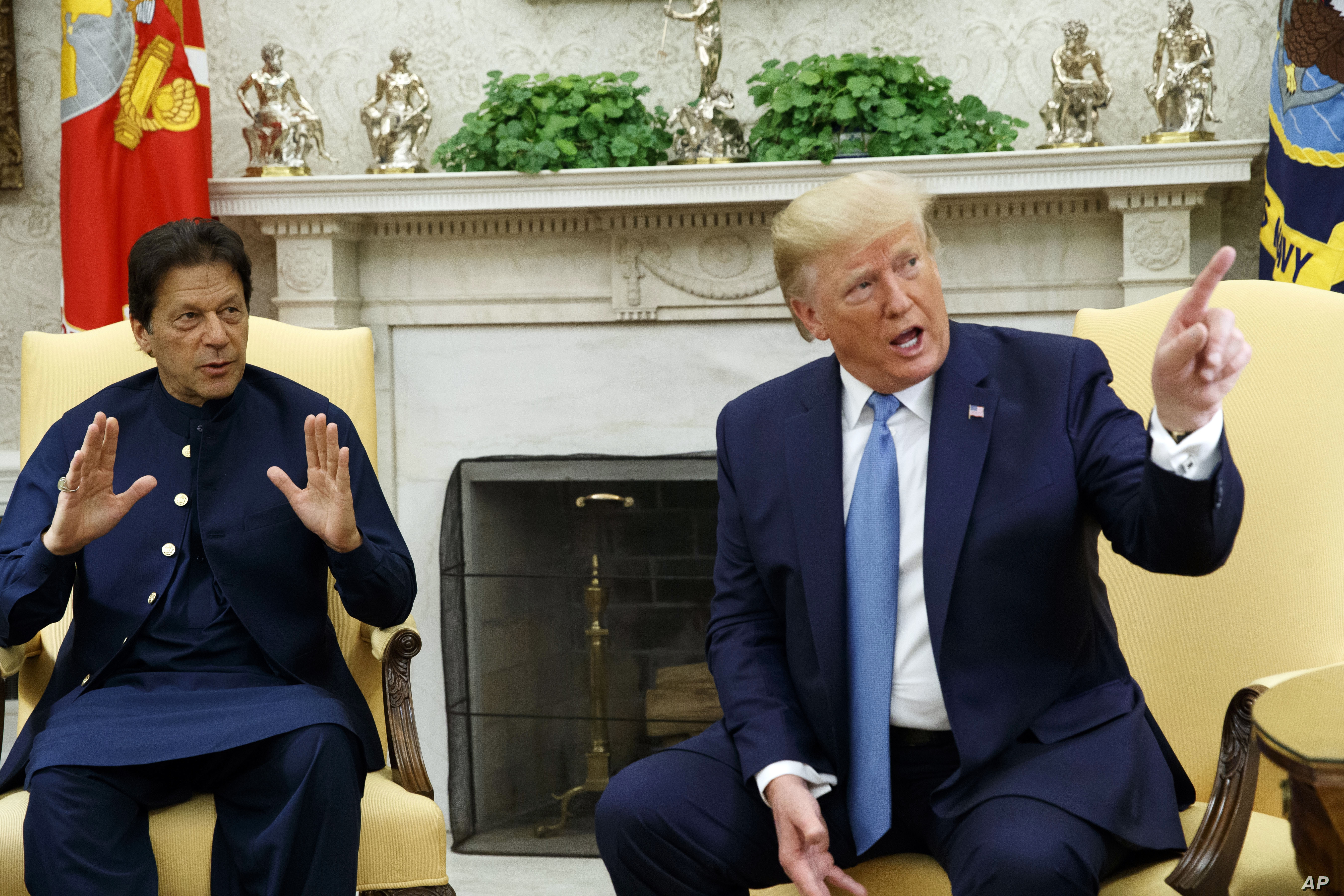
President Donald Trump (R) speaks during a meeting with Pakistani Prime Minister Imran Khan, Washington, July 22, 2019
The US State Department chose Friday to announce the decision to approve a $125 million aid package providing technical support to Pakistan’s fleet of F-16 fighter aircraft. Ironically, the news reached Delhi on the 20th anniversary of the Kargil Vijay Diwas, which symbolises, as Prime Minister Narendra Modi put it on Saturday, “India’s might, determination, capability, discipline and patience” to thwart Pakistan’s hostile acts.
Clearly, Washington has begun to “incentivise” Pakistan, in the downstream of the talks between President Trump and Prime Minister Imran Khan at the White House on July 22.
Meanwhile, the Pentagon also notified on Friday about a proposed $670 million follow-on support programme for the eleven C-17 Globemaster-III air-lift aircraft sold by the US to India in the recent years. By holding out the carrot to India, Washington hopes to create the hype that it is also favouring Delhi.
The intention here is to finesse Delhi’s criticism over the revival of US military aid to Pakistan. Of course, it will be a delusional thought that the US is balancing India and Pakistan. In reality, the Pentagon’s India proposal is a purely commercial transaction — “after-sales service”, which will generate good business for the US vendors — while the military aid to Pakistan providing technical and logistics support for its F-16 fighter jets is on concessional terms and signifies a major political decision.
Delhi will take note that the proposed US military aid may significantly enhance Pakistan’s offensive capability insofar as some of the F-16 jets are capable of delivering nuclear weapons.
Indeed, the “big picture” emerging out of all this is that the US and Pakistan are marching ahead in tandem to implement the decisions taken by Trump and Imran Khan to swiftly end the Afghan war.
No sooner than Imran Khan left Washington on July 23, the chairman of the US Joint Chiefs of Staff General Joe Dunford traveled to Afghanistan’s capital of Kabul for consultations with American, NATO and Afghan officials.
Dunford said he wants to ensure Gen. Austin S. Miller, the US commander in Afghanistan, has all he needs. He added that he wanted to take the pulse of US military operations in the country. Indeed, the pulse rate is rather high, as the US withdrawal from Afghanistan looms large.
Dunford insisted that the negotiations have not changed the military mission in the country. “Day to day, the mission hasn’t changed for General Miller and the team, and they are still taking the fight to the Taliban and supporting the Afghan military,” he said.
But that’s putting a brave face. Evidently, the US is pushing forward a “face-saving way out of Afghanistan,” as former CIA deputy director Michael Morell has told Axios. The message has gone down the line in the State Department and the Pentagon that Trump wants to move quickly toward a deal to end the war in Afghanistan. Morell is deeply sceptical whether a deal with the Taliban will secure peace.
He said, “I would bet that the US intelligence community and policymakers have a pretty good understanding of what the Taliban’s intentions are. So we’re making a deal that we know isn’t going to be kept just to save face, just to maintain honour.” Morell repeated his past warnings that the Taliban is “ideologically not disposed to sharing power.”
However, an apocalyptic scenario cannot deter Washington anymore. On a parallel mission, the US special representative on Afghanistan Zalmay Khalilzad also took off on July 23 from Washington to Kabul (where he is now speaking with members of the Afghan government as he works to encourage inter-Afghan conversations between the Taliban and the government.)
In immediate terms, Khalilzad expects Pakistan to deliver on the promise that Imran Khan made to Trump to the effect that he plans to meet with the Taliban to persuade them to hold negotiations with the government in Afghanistan. (Taliban has welcomed such a meeting.)
Imran Khan had said, “Now, when I go back after meeting President Trump … I will meet the Taliban and I will try my best to get them to talk to the Afghan government so that the elections in Afghanistan must be inclusive where the Taliban also participate in it.”
It may seem a tough call, but the news from Kabul on Saturday suggests that Pakistan may have made some headway already. The Afghan state minister for peace affairs Abdul Salam Rahimi announced on Saturday that “We (Afghan government) are preparing for direct talks (with the Taliban.) The government will be represented by a 15-member delegation. We are working will all sides and hope that in the next two weeks the first meeting will take place in a European country.”
The Norwegian capital Oslo is mentioned as the venue for the crucial meeting between the representatives of the Afghan government and the Taliban. The Taliban has not yet budged from its longstanding demand that a deal must be forged with the US first. Possibly, a deal may be announced after the 9th round of US-Taliban talks in Doha in the coming week.
Indeed, we are witnessing an utterly fascinating spectacle of diplomatic pirouette being played out between and amongst five main protagonists — Trump who is demanding an expeditious US withdrawal from Afghanistan, assuming Imran Khan will deliver on his promises; Imran Khan, in turn, going through the motions of persuading the Taliban to be reasonable while expecting generous US reciprocal moves to accommodate Pakistani interests; Ashraf Ghani, Afghan president, seeing the writing on the wall that US withdrawal is unstoppable, whilst still hoping to secure a second term in office; Khalilzad pushing the reluctant Afghan government to fall in line with a Taliban deal, while also negotiating with the Taliban for an orderly US withdrawal, albeit with a weak hand; and the Taliban on a roll, sensing victory. There are caveats galore. But the compass has been set.
